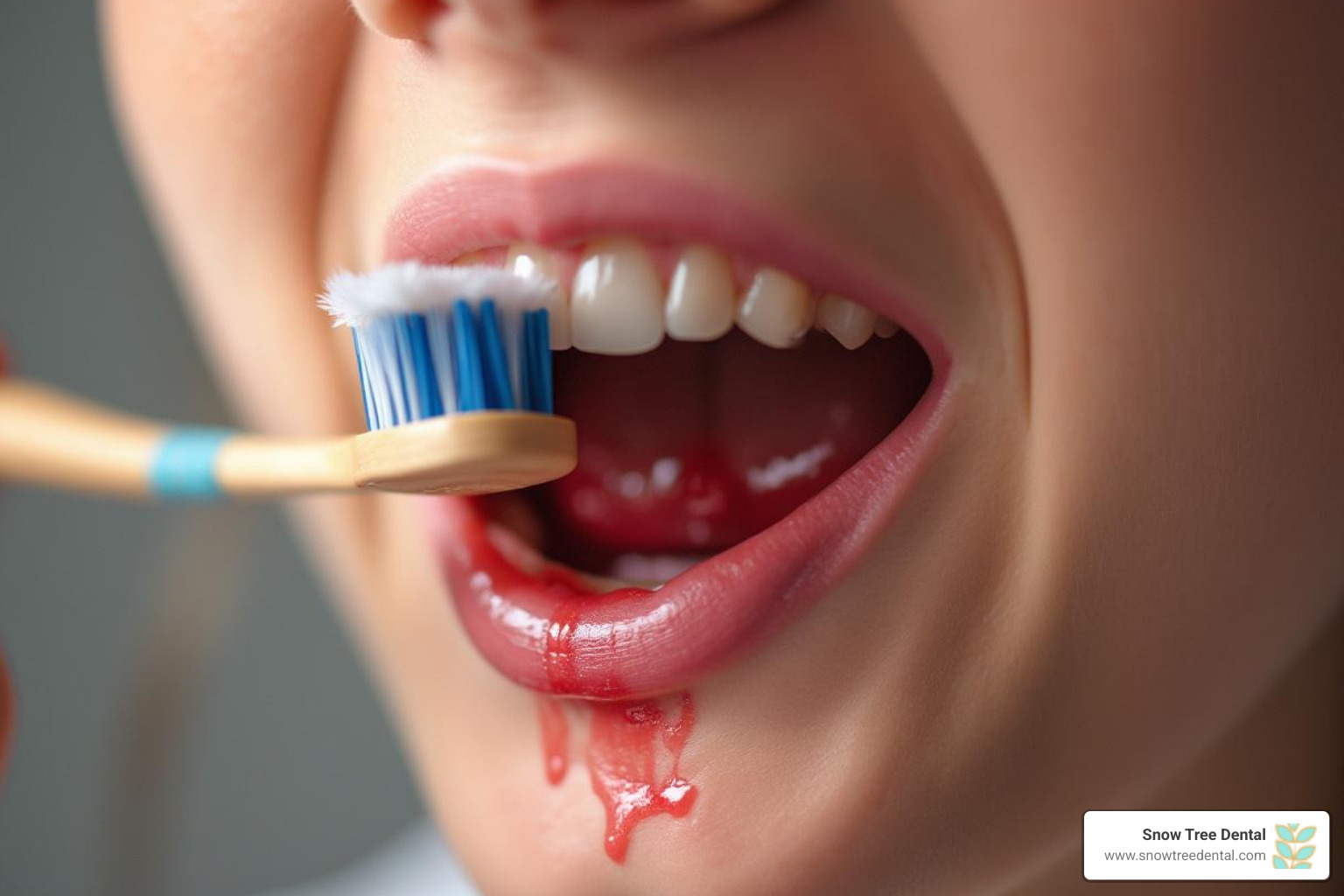Bleeding gums treatment: 3 Steps to Healthy Gums
Understanding When Your Gums Need Help
Bleeding gums treatment starts with recognizing that blood in your sink after brushing isn’t normal. Almost half of all adults in the United States have some form of gum disease, and bleeding gums are often the first warning sign your mouth sends you.
Quick bleeding gums treatment options:
- Gentle brushing with a soft-bristled toothbrush twice daily
- Daily flossing to remove plaque between teeth
- Salt water rinses to reduce inflammation and promote healing
- Professional dental cleaning for plaque removal below the gum line
- See a dentist if bleeding continues for more than 7-10 days
When you notice blood on your toothbrush or dental floss, it’s usually your gums telling you they’re irritated and inflamed – a condition called gingivitis. The good news? Gingivitis is completely reversible with proper care.
Most bleeding gums happen because of plaque buildup at the gum line. This sticky film of bacteria irritates your gums, making them red, swollen, and prone to bleeding. Without treatment, gingivitis can progress to more serious gum disease that damages the tissues and bone supporting your teeth.
But here’s what many people don’t realize: bleeding gums can also signal other health issues like vitamin deficiencies, hormonal changes, or even stress affecting your immune system.
I’m Dr. Muna Mohammad, and I’ve helped countless Houston families overcome bleeding gums through personalized bleeding gums treatment plans that address both immediate symptoms and long-term oral health. My approach combines the latest research with gentle, patient-centered care to ensure you get the most effective treatment for your specific situation.
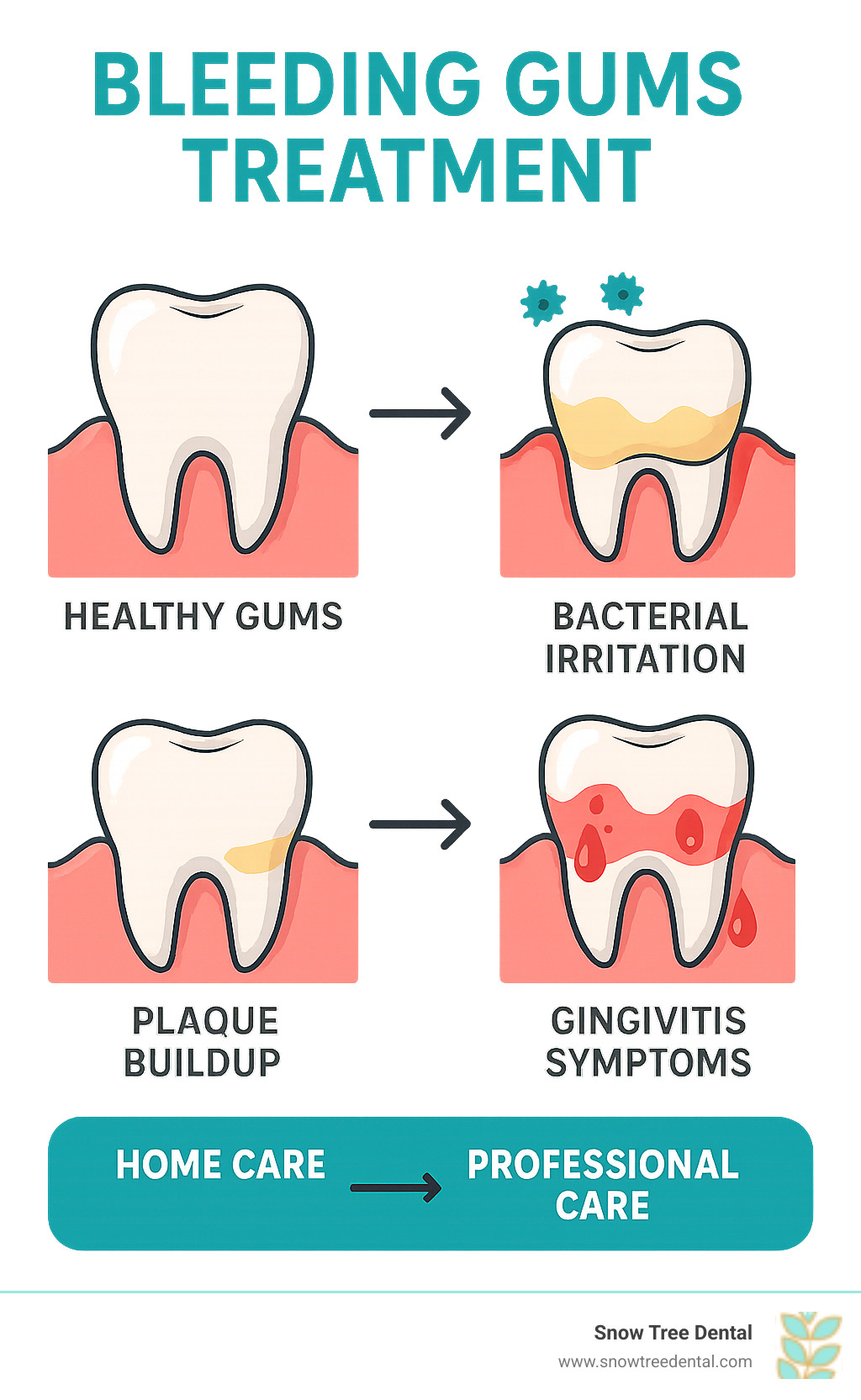
Why Are My Gums Bleeding? Uncovering the Common Causes
If you’ve ever seen pink or red in the sink after brushing your teeth, you’re probably wondering what’s going on in your mouth. The truth is, bleeding gums treatment starts with understanding what’s causing the problem in the first place.
The main culprit behind bleeding gums is something that’s probably building up on your teeth right now: plaque. This sticky, colorless film of bacteria forms on your teeth throughout the day. When plaque isn’t removed through regular brushing and flossing, it irritates your gums, causing them to become inflamed and bleed. Think of bleeding gums as your mouth’s way of waving a red flag.
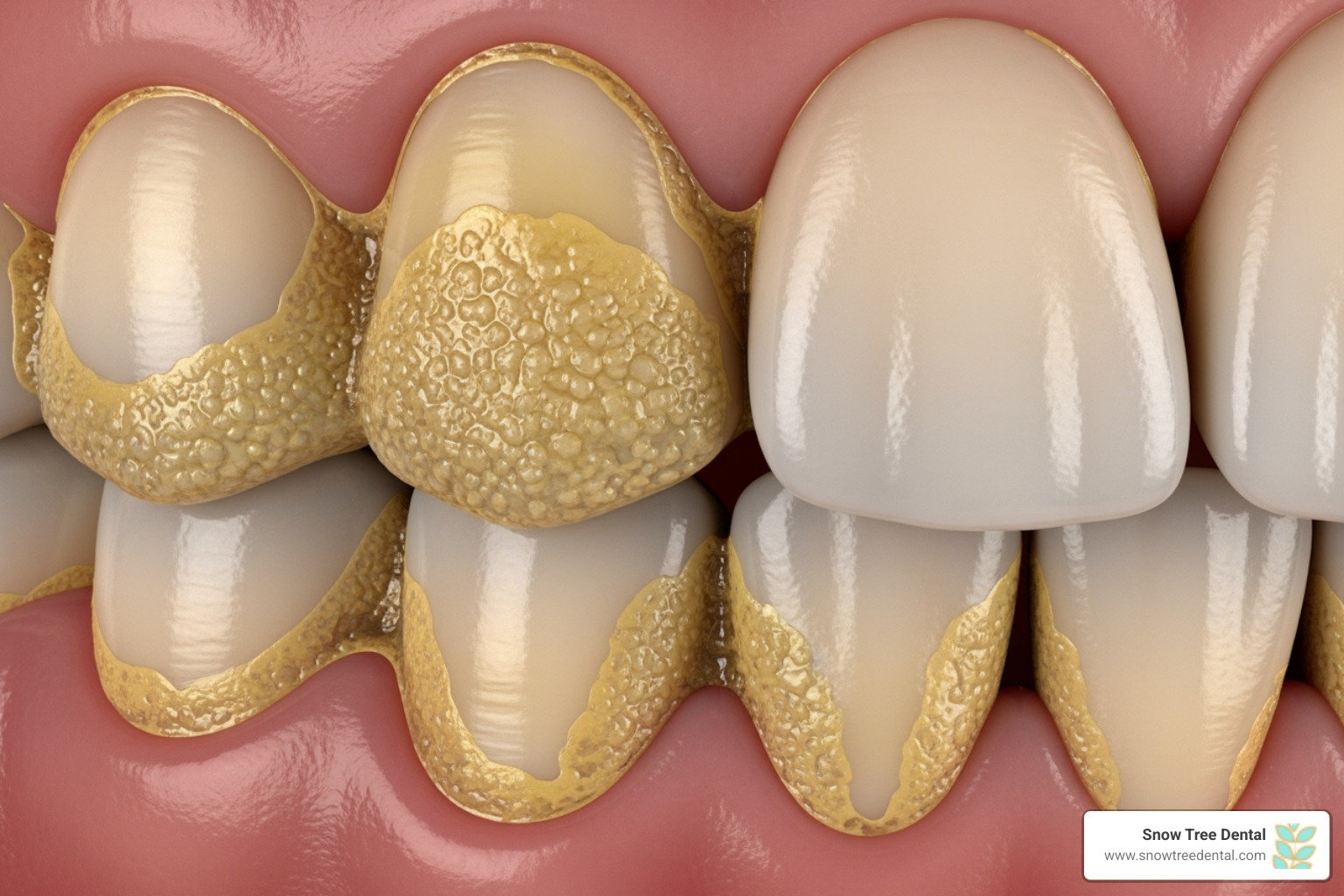
The Role of Plaque and Gum Disease (Gingivitis)
Here’s what happens when plaque overstays its welcome. If you don’t brush and floss regularly, that soft plaque hardens into tartar (also called calculus). Tartar creates a rough surface that gives bacteria an even better place to stick and multiply.
This bacterial party leads to gingivitis – the early stage of gum disease. Your gums become red, swollen, and tender. They bleed easily when you brush or floss. The good news? Gingivitis is completely reversible with proper care.
But here’s the serious part: if gingivitis goes untreated, it can progress to periodontitis. This advanced gum disease damages the tissues and bone that support your teeth, and it’s the leading cause of tooth loss in adults. The Mayo Clinic’s guide on gingivitis provides detailed information about these stages and their symptoms.
Lifestyle and Systemic Health Factors
While plaque is the main troublemaker, other factors can make your gums more likely to bleed. Sometimes the cause might surprise you.
Brushing too hard is a common mistake. You might think scrubbing harder will clean better, but aggressive brushing actually injures your delicate gum tissue. Gentle pressure with a soft-bristled brush works much better.
Hormonal changes during pregnancy, menopause, or even your monthly cycle can make gums more sensitive and prone to bleeding. If you’re pregnant, pay extra attention to your oral hygiene – those hormone shifts can trigger gum problems.
Smoking is particularly harmful to your gums. It weakens your body’s ability to fight infection and doubles your risk of gum disease. The CDC explains how smoking damages your gums and makes healing much harder.
Stress affects more than just your mood – it weakens your immune system, making it harder for your body to fight off gum infections. Research shows that chronic stress increases your risk of developing periodontal disease.
Some medications, especially blood thinners, can make your gums bleed more easily. Always let your dentist know about any medications you’re taking.
Vitamin deficiencies can also cause bleeding gums. Vitamin C helps keep your gum tissue healthy and strong. Without enough of it, your gums become weak and bleed easily. Vitamin K is essential for proper blood clotting, so a deficiency can lead to excessive bleeding throughout your body, including your gums.
Finally, diabetes makes you more susceptible to infections, including gum disease. High blood sugar levels can make it harder for your body to heal and fight bacteria.
Understanding these various causes helps us create the most effective bleeding gums treatment plan for your specific situation. The key is identifying what’s causing your bleeding gums so we can address it properly.
Your Guide to At-Home Care for Bleeding Gums
Here’s something that might surprise you: most cases of bleeding gums can actually be treated right in your own bathroom. When gingivitis is the culprit behind your bleeding gums treatment needs, consistent home care can completely reverse the problem.
The secret isn’t complicated or expensive – it’s all about developing good habits and sticking with them. Think of it like tending a garden: a little daily attention goes much further than occasional intensive work.
The Best Brushing and Flossing for Bleeding Gums Treatment
Let’s start with the basics, but done right. You’ve been brushing your teeth since childhood, but when it comes to bleeding gums treatment, technique matters more than you might think.
Choose the right toothbrush – and we’re talking soft bristles only. I know it seems logical that firmer bristles would clean better, but they’re actually too harsh for irritated gums. Those hard bristles can make bleeding worse and damage delicate gum tissue that’s trying to heal.
Brush with gentle pressure using small, circular motions. Angle your toothbrush at about 45 degrees toward your gum line – this helps clean the area where plaque loves to hide. Spend a full two minutes brushing, twice daily. If you’re rushing through in 30 seconds, you’re not giving your gums the care they need. The proper brushing technique from Mouth Healthy provides excellent visual guidance if you want to double-check your form.
Now, let’s talk about flossing – the step many people skip, but absolutely shouldn’t when dealing with bleeding gums. Daily flossing removes plaque and bacteria from places your toothbrush simply cannot reach. Yes, your gums might bleed when you first start flossing regularly, but don’t let that scare you off. That bleeding is actually proof that your gums need this care.
Use the C-shape method: wrap about 18 inches of floss around your middle fingers, then gently slide it between your teeth. Curve the floss into a C-shape around each tooth and move it up and down, cleaning both sides. Be gentle but thorough – you’re not trying to saw through wood!
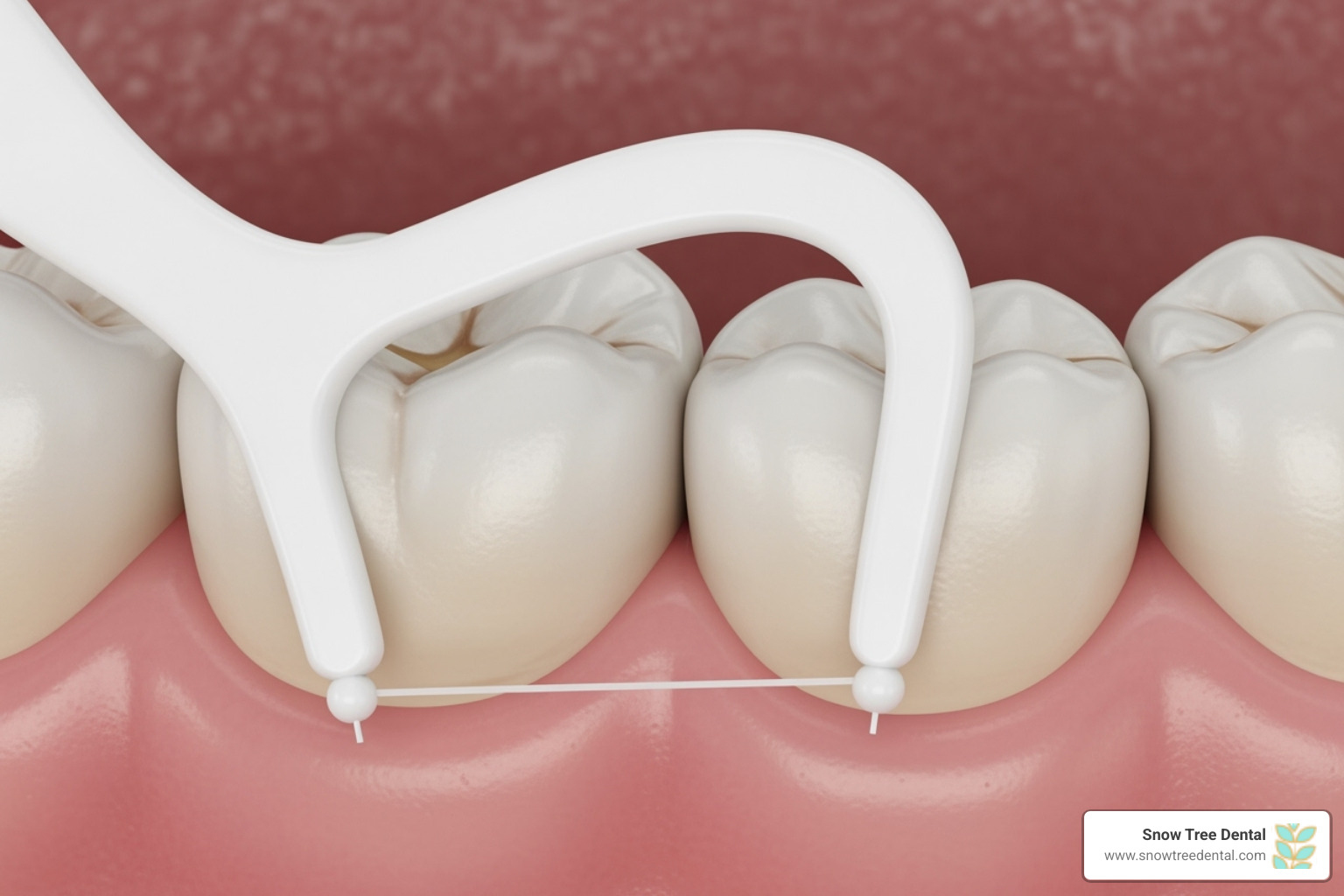
Therapeutic Rinses and Natural Remedies
Sometimes your gums need a little extra TLC beyond brushing and flossing. That’s where therapeutic rinses come in – think of them as a soothing spa treatment for your mouth.
Warm salt water rinses are incredibly effective and beautifully simple. Salt has natural antibacterial properties that help reduce the bacteria causing your gum inflammation. It also helps soothe irritated tissues and can reduce swelling. Mix half a teaspoon of salt in a glass of warm water and swish it around your mouth for 30-60 seconds, three to four times daily.
Diluted hydrogen peroxide rinses can also help, but use them with caution. The antiseptic properties kill bacteria and reduce inflammation. Mix equal parts of 3% hydrogen peroxide with water, swish for 30 seconds, then spit it out completely. Never swallow this mixture, and limit use to 2-3 times per week to avoid irritating your mouth.
Green tea offers a gentler approach with its natural antioxidants that fight inflammation. You can drink it regularly or use cooled green tea as a mouth rinse. It’s a pleasant way to support your gum health while enjoying a relaxing moment.
Simple Rinse Recipes:
- Saltwater Rinse: Mix 1/2 teaspoon of salt in 8 ounces of warm water. Swish for 30-60 seconds, 3-4 times daily.
- Hydrogen Peroxide Rinse: Mix equal parts 3% hydrogen peroxide and water. Swish for 30 seconds, 2-3 times per week. (Do not swallow.)
The Impact of Diet and Vitamins on Gum Health
What you eat plays a bigger role in bleeding gums treatment than most people realize. Your gums need proper nutrition to heal and stay healthy, just like any other part of your body.
Vitamin C is crucial for healthy gum tissue. Load up on oranges, bell peppers, strawberries, and broccoli. This vitamin helps your body repair connective tissue and keeps your gums strong. Vitamin K is equally important because it helps your blood clot properly. You’ll find it in leafy greens like spinach, kale, and collard greens.
Limiting sugar and refined carbohydrates gives the harmful bacteria in your mouth less fuel to work with. Every time you eat something sugary or starchy, those bacteria have a feast and produce more plaque. The Best and Worst Foods for your Teeth from U of Rochester provides excellent guidance on making tooth-friendly food choices.
Crunchy vegetables like carrots and celery act like natural toothbrushes, helping scrub away plaque as you chew. They also stimulate saliva production, which naturally cleanses your mouth.
Staying well-hydrated helps wash away food particles and bacteria throughout the day. Water is your mouth’s best friend – it keeps tissues moist and helps prevent the dry conditions where harmful bacteria thrive.
Consistency is everything when it comes to home care. These simple steps, done regularly, can make a remarkable difference in your gum health within just a few weeks.
Professional Bleeding Gums Treatment: When to See a Dentist
Sometimes your best efforts at home just aren’t enough to stop the bleeding. While daily brushing, flossing, and salt water rinses work wonders for mild gingivitis, persistent bleeding gums often need professional attention. Think of it this way: you wouldn’t ignore a persistent cough for months, so why ignore bleeding gums?
The truth is, bleeding gums treatment sometimes requires tools and expertise that only a dental professional can provide. More importantly, what looks like simple gingivitis might actually be something more serious brewing beneath the surface.
Warning Signs You Shouldn’t Ignore
Most of us have experienced occasional gum sensitivity after being a bit lazy with our flossing routine. But certain warning signs tell us it’s time to pick up the phone and schedule that dental appointment we’ve been putting off.
Bleeding that lasts more than a week is your mouth’s way of waving a red flag. If you’ve been consistent with gentle brushing, daily flossing, and salt water rinses for 7 to 10 days and still see blood, your gums need professional help.
Severe or random bleeding is another clear signal. When your gums bleed heavily without any obvious trigger, or when light brushing causes significant bleeding, something more serious might be happening.
Persistent bad breath that doesn’t improve with better oral hygiene often indicates bacterial overgrowth deep in your gum pockets. This kind of halitosis has a distinct, unpleasant smell that regular mouthwash can’t mask.
Watch for receding gums too. When your gums start pulling away from your teeth, exposing more of the tooth surface, gum disease is likely advancing. You might notice your teeth looking longer than before.
Pus between your teeth and gums is a definitive red flag – this means infection has taken hold. Similarly, loose teeth or pain when chewing signal that the infection may have reached the bone supporting your teeth.
What to Expect During Your Dental Exam
When you visit us at Snow Tree Dental for bleeding gums, we take a comprehensive approach to understand exactly what’s happening in your mouth. Our goal is to create the most effective bleeding gums treatment plan custom specifically for you.
We’ll start with a thorough medical history review. This isn’t just small talk – medications like blood thinners, health conditions like diabetes, and even stress levels can all impact your gum health. Understanding your complete health picture helps us provide better care.
During the visual examination, we’ll carefully inspect your gums for signs of inflammation, swelling, and recession. We’re looking at color changes, texture, and how your gums respond to gentle pressure.
Periodontal probing sounds more intimidating than it actually is. We use a small, ruler-like instrument to gently measure the pockets around your teeth. Healthy gums create shallow pockets of 1-3 millimeters, while deeper pockets often indicate gum disease.
Dental X-rays give us the complete picture by showing us what’s happening with the bone that supports your teeth. Sometimes gum disease causes bone loss that isn’t visible during a regular examination.
At Snow Tree Dental, we believe prevention is the best medicine. You can learn more about our proactive approach through our Preventative Dentistry services.
Professional Bleeding Gums Treatment Options
Once we understand what’s causing your bleeding gums, we can recommend the most effective treatment approach. The good news is that we have many options, from simple cleanings to advanced therapies.
For mild gingivitis, a professional dental cleaning often works like magic. We’ll remove all the plaque and tartar buildup above and below your gum line – the stubborn stuff your toothbrush just can’t reach. Many patients are amazed at how quickly their gums stop bleeding after a thorough professional cleaning.
Scaling and root planing – often called deep cleaning – goes further for more advanced cases. We remove plaque and tartar from deep below the gum line and smooth the tooth root surfaces so bacteria can’t easily reattach. This treatment gives your gums the clean slate they need to heal.
Sometimes we’ll recommend antibiotics to fight persistent infections. These might be oral medications or antibiotic gels applied directly into the infected gum pockets for targeted treatment.
Laser therapy represents the cutting edge of gum treatment. This minimally invasive option removes infected tissue and promotes faster healing with less discomfort than traditional methods.
For severe cases where significant tissue or bone loss has occurred, we might discuss surgical options. These could include pocket reduction surgery, bone grafting, or gum grafting procedures designed to restore your mouth’s health and function.
The American Academy of Periodontology provides excellent Information on Periodontal Disease Prevention for those wanting to learn more about maintaining healthy gums.
At Snow Tree Dental, we’re committed to providing comprehensive, comfortable care that fits your schedule and budget. Learn more about our complete approach to oral health through our General Dentistry services.
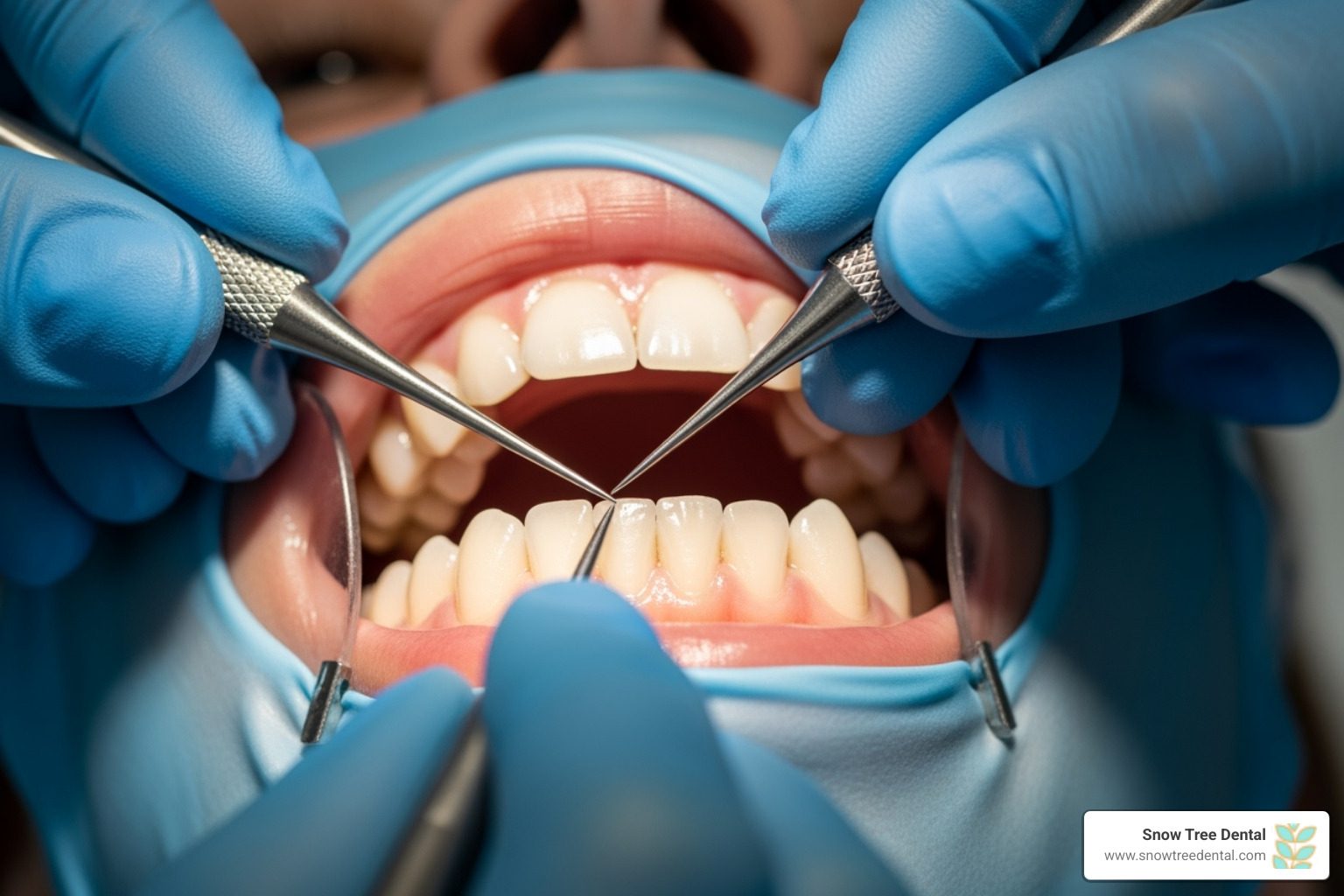
Frequently Asked Questions about Bleeding Gums
I know that when you’re dealing with bleeding gums, you probably have a lot of questions swirling around in your head. Over the years, I’ve heard these same concerns from countless patients, and I want to address the most common ones here. Every situation is unique, but these answers should help put your mind at ease.
How long does it take for gums to stop bleeding with treatment?
This is probably the question I hear most often, and I completely understand why you’d want to know! The good news is that with consistent bleeding gums treatment and proper home care, most people see their gums stop bleeding within 3 to 10 days.
Now, I always tell my patients that this timeline can vary quite a bit. It really depends on how severe the inflammation was to begin with and how committed you are to your new oral hygiene routine. If you’ve been skipping flossing for months (no judgment here – we’ve all been there!), it might take closer to that 10-day mark.
Here’s something that can really speed things up: professional cleaning. When we remove all that built-up plaque and tartar that your toothbrush can’t reach, your gums often respond much faster. I’ve seen patients whose gums stopped bleeding within just a few days after a thorough cleaning combined with improved home care.
Can stress make your gums bleed?
Oh, absolutely! This surprises a lot of people, but stress really can wreak havoc on your gums. I’ve noticed that many of my patients who are going through particularly stressful periods – like job changes, family issues, or major life transitions – often come in with bleeding gums.
Here’s what’s happening: when you’re chronically stressed, your immune system takes a hit. Your body is so busy dealing with that stress response that it can’t fight off infections as effectively, including the bacterial infections that cause gum inflammation.
It becomes this frustrating cycle where stress makes your gums more vulnerable to bleeding, and then you stress about your bleeding gums! The research backs this up too. Studies have shown that emotional stress negatively impacts our immune system, making it much harder for our bodies to combat gum infections. You can read more about this connection in this research on stress and periodontal health.
So if you’ve been under a lot of pressure lately and notice your gums bleeding more, that could very well be connected.
Are bleeding gums always a sign of a serious disease?
This is such an important question, and I want to give you a balanced answer. Most of the time, bleeding gums indicate gingivitis, which sounds scary but is actually very treatable and completely reversible. It’s your gums’ way of waving a little red flag saying “Hey, pay attention to me!”
However, bleeding gums can sometimes point to other issues that need attention. Vitamin deficiencies are more common than you might think – particularly vitamin C and K deficiencies can make your gums prone to bleeding. I’ve also seen bleeding gums that were linked to systemic health conditions like diabetes. Some of my diabetic patients notice their gums bleeding more when their blood sugar isn’t well controlled.
There are also some blood disorders like hemophilia or leukemia that can cause gum bleeding, though these are much less common. And certain medications, especially blood thinners, can make your gums more likely to bleed.
This is exactly why I always encourage patients not to just ignore bleeding gums or assume they’ll go away on their own. An accurate diagnosis is so important because the treatment can vary significantly depending on what’s causing the bleeding. What works for plaque-induced gingivitis might not address a vitamin deficiency or medication side effect.
The bottom line? While bleeding gums usually aren’t a sign of something serious, they’re always worth investigating to make sure you get the right bleeding gums treatment for your specific situation.
Conclusion: Take Control of Your Oral Health Today
Your gums are speaking to you, and bleeding gums treatment starts with listening to what they’re saying. Throughout this guide, we’ve finded that bleeding gums aren’t just a minor inconvenience you should ignore – they’re your body’s way of waving a red flag, asking for help.
Whether it’s plaque buildup causing gingivitis, aggressive brushing habits, hormonal changes, or even stress affecting your immune system, the good news is that most causes of bleeding gums are completely treatable. The key is taking action before a small problem becomes a big one.
Your first line of defense happens right at home. Gentle brushing with a soft-bristled toothbrush, daily flossing, and simple remedies like salt water rinses can work wonders for early-stage gum inflammation. Add in a diet rich in vitamin C and K, and you’re giving your gums the nutrients they need to heal and stay healthy.
But sometimes, home care isn’t enough. When bleeding persists for more than a week, when you notice persistent bad breath, receding gums, or any of the other warning signs we’ve discussed, that’s when professional help becomes essential. Ignoring these signals can lead to periodontitis, a serious condition that can result in tooth loss and affect your overall health.
At Snow Tree Dental, we understand that dental visits can feel overwhelming, especially when you’re dealing with bleeding gums. That’s why we’ve built our practice around making your experience as comfortable and convenient as possible. Our modern technology ensures efficient, gentle treatment, while our flexible scheduling – including evenings and Saturdays – means you don’t have to put your oral health on hold because of a busy schedule.
We believe quality dental care should be accessible to everyone. Our transparent pricing and in-house dental plan eliminate surprises and make it easier for Houston families to get the care they need without breaking the bank.
The most important step you can take today is simply deciding not to ignore what your gums are telling you. Bleeding gums treatment is most effective when we catch problems early, and every day you wait is another day for inflammation to potentially progress.

Your smile is worth protecting, and we’re here to help you every step of the way. Don’t let bleeding gums steal your confidence or compromise your health.
Schedule your appointment with us today and let us help you achieve a healthy, confident smile. You can also explore our full range of Services or simply Contact Us directly with any questions you may have.



